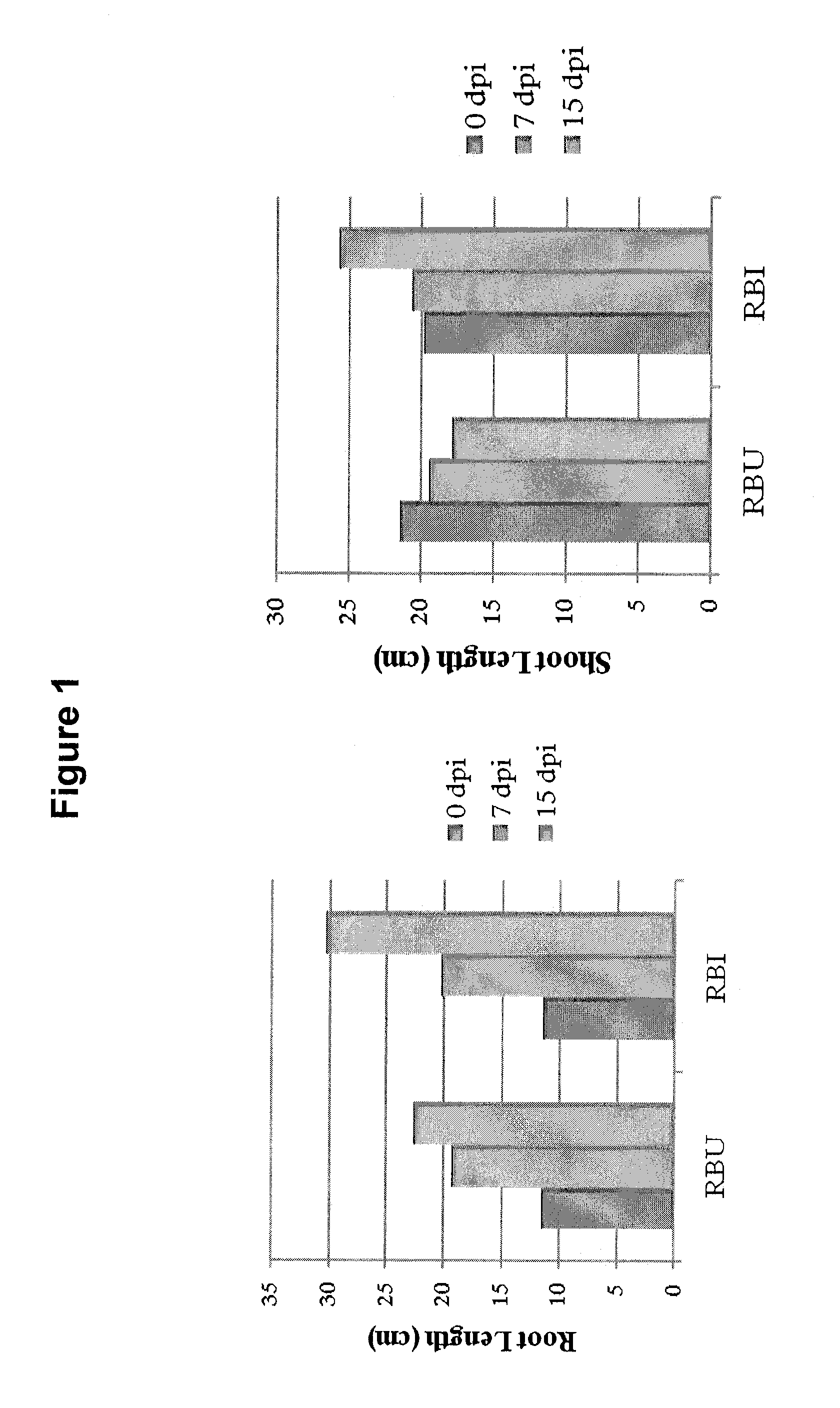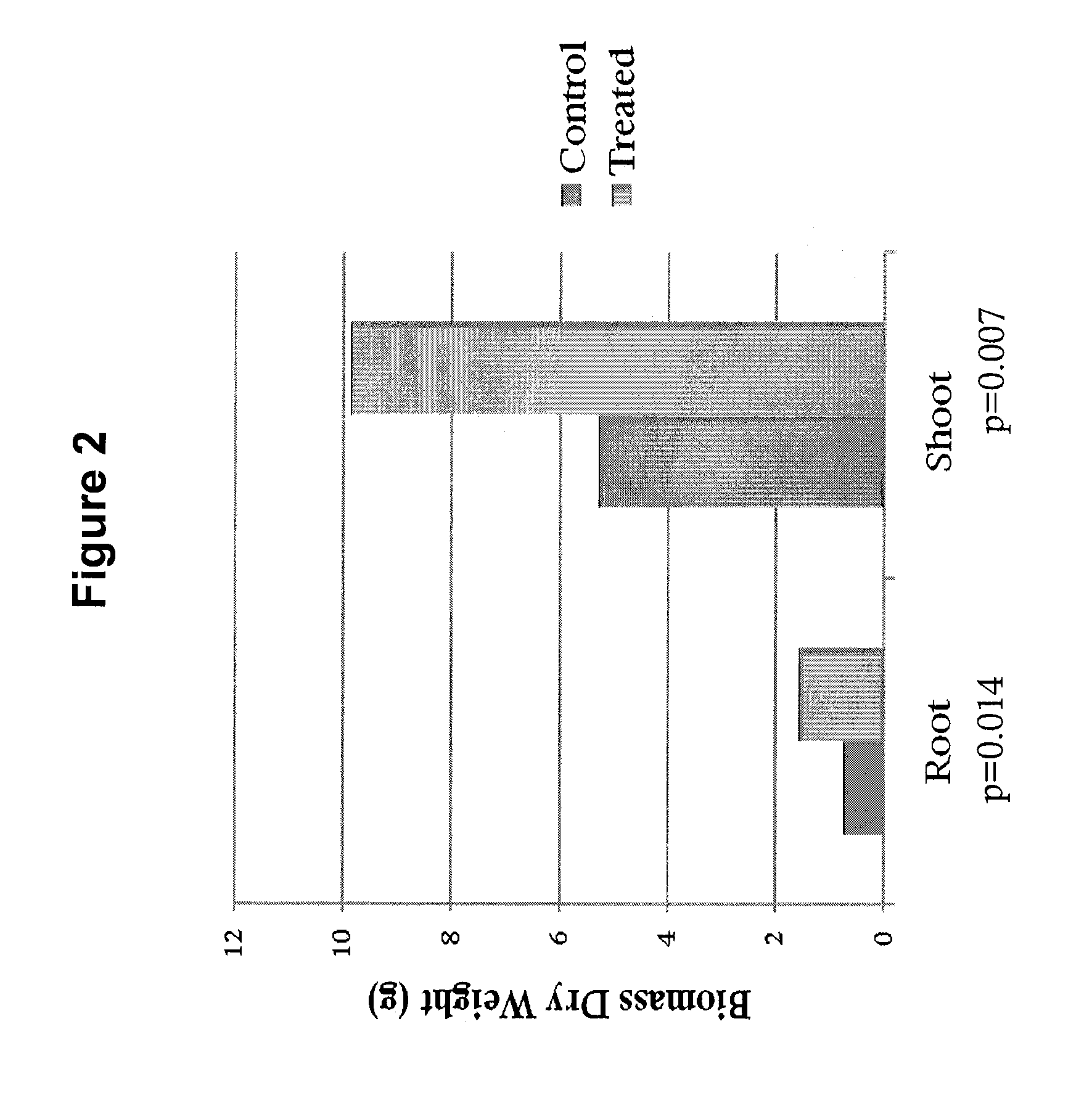Compositions and methods for improving rice growth and restricting arsenic uptake
a technology of arsenic uptake and compositions, applied in the field of compositions and methods for improving rice growth and restricting arsenic uptake, can solve the problems of economic significant crop loss, further contributing to crop loss, and estimated 40% loss of crop yield, and achieve the effect of reducing the concentration of arseni
- Summary
- Abstract
- Description
- Claims
- Application Information
AI Technical Summary
Benefits of technology
Problems solved by technology
Method used
Image
Examples
example 1
[0047]Rice plants (Nipponbare) were inoculated with about 108 CFU / ml of a combination of the rice rhizosphere isolates described above in Table 1. As illustrated in FIG. 1 (in which RBI refers to rhizobacteria inoculated and RBU refers to rhizobacteria uninoculated), the rice rhizosphere isolates promoted rice growth, as measured at 0 days post inoculation (dpi), 7 dpi, and 15 dpi. FIG. 2 illustrates the average biomass values in rice treated with a mixture of the rice rhizosphere isolates shown in Table 1 at 80 dpi (i.e., at harvest), at which time approximately 50% increase in shoot biomass was observed compared to control.
example 2
[0048]To evaluate if rice rhizosphere isolates colonize rice roots, the applicants inoculated rice plants (cultivar Nipponbare) with the rice microbial isolates described above and examined the roots of the rice plants 96 hrs post-inoculation by confocal scanning laser microscopy. Observations confirmed that the beneficial rice microbial isolates form biofilm on the root surface. In particular, the data suggest that rice microbial isolates efficiently colonize the rice roots post 96 hrs of treatment, indicating that rice roots support the colonization of beneficial microbes. Applicants previously demonstrated that rhizobacteria intervene with a plant's guard cell functioning to restrict foliar pathogen entry. The entry of a foliar pathogen through the stomatal pores present in leaves is restricted due to root colonization by the beneficial microbe. To evaluate if treatment of rice plants with rice microbial isolates inflicts any changes in stomatal aperture, the applicants analyzed ...
example 3
[0049]To evaluate if the rice microbial isolates described above attenuate the growth of rice blast (i.e., Magnaporthe oryzae or Magnaporthe grisea) the applicants exposed M. oryzae to rice microbial isolate cultures. Qualitative compartment plates and quantitative data showed that rice microbial isolates attenuated the growth of M. oryzae as shown by reduced radial growth in the rice microbial isolate-exposed fungal cultures. Comparison with the control (TY) demonstrates the extent to which the pathogen would grow with no treatment. These results are summarized in table 3 and FIG. 4. Pseudomonas (“EA105”) and Pantoea agglomerans (“EA106”) reduced the radial growth of Magnaporthe oryzae by about 77% and about 50%, respectively. Applicants therefore observed rice microbial isolate-mediated induced systemic resistance in rice to Magnaporthe oryzae.
[0050]
TABLE 3Effect of rice microbial isolates on growth of Magnaportheoryzae in vitro.Avg Diameter (cm)% of controlTY Control3.175100EA101...
PUM
 Login to View More
Login to View More Abstract
Description
Claims
Application Information
 Login to View More
Login to View More - R&D
- Intellectual Property
- Life Sciences
- Materials
- Tech Scout
- Unparalleled Data Quality
- Higher Quality Content
- 60% Fewer Hallucinations
Browse by: Latest US Patents, China's latest patents, Technical Efficacy Thesaurus, Application Domain, Technology Topic, Popular Technical Reports.
© 2025 PatSnap. All rights reserved.Legal|Privacy policy|Modern Slavery Act Transparency Statement|Sitemap|About US| Contact US: help@patsnap.com



